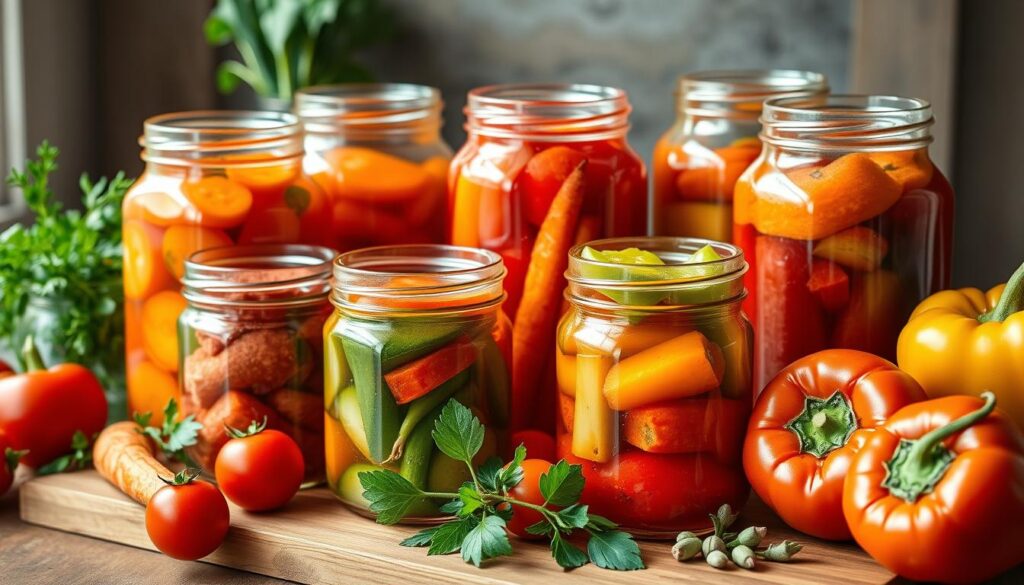I love gardening and cooking at home. I’ve learned how important it is to save fresh veggies. In this guide, I’ll share my best tips on canning, freezing, and drying. These methods help keep your veggies fresh for longer, so you can enjoy them all year.
Key Takeaways
- Canning, freezing, and drying are effective ways to preserve fresh vegetables for long-term storage
- Preserving vegetables helps retain their nutritional value and allows you to enjoy them year-round
- Proper equipment and techniques are essential for successful vegetable preservation
- Canning, freezing, and drying each have their own advantages and considerations
- Storing preserved vegetables correctly is crucial to maintain freshness and quality
How to Preserve Fresh Vegetables: Canning, Freezing, and Drying Tips
Preserving fresh vegetables is a great way to cut down on food waste. It also keeps you stocked with healthy food. I’ll show you how to can, freeze, and dry vegetables. This way, you can pick the best method for you.
Canning Vegetables: A Time-Honored Tradition
Canning is a traditional way to keep vegetables fresh for a year or more. You seal them in jars or cans to stop them from spoiling. First, clean and chop the veggies. Then, heat them to kill off bad bacteria.
Freezing for Long-Lasting Freshness
Freezing is another popular method. It quickly cools the veggies to keep their nutrients and taste. Blanching them before freezing helps keep their texture and color. It’s important to package them right to avoid freezer burn.
Dehydrating for Compact Storage
Drying or dehydrating removes moisture from veggies, making them light and shelf-stable. Use a dehydrator or oven to dry them out slowly. Dried veggies can be soaked and used in many dishes.
| Preservation Method | Advantages | Drawbacks |
|---|---|---|
| Canning |
|
|
| Freezing |
|
|
| Drying/Dehydrating |
|
|
Choosing between canning, freezing, and drying depends on your needs and what you like. Try out different methods to see what works best for you.
Benefits of Preserving Fresh Vegetables
Preserving fresh vegetables has many benefits. It’s not just about saving time. It also helps keep nutrients in and can save you money. Canning, freezing, and drying are all great ways to enjoy your produce all year.
Nutritional Value Retention
Methods like canning, freezing, or drying help keep veggies full of vitamins and minerals. In fact, studies show that up to 90% of the nutrients stay in. This means your family gets the health benefits they need all year.
Cost Savings
Buying veggies out of season can be pricey. But, preserving them when they’re in season saves a lot of money. You can enjoy your veggies without breaking the bank.
Choosing to can, freeze, or dry your veggies is smart. It keeps them nutritious and saves you money. It’s a great choice for anyone who cares about health and budget.

Essential Equipment for Vegetable Preservation
Preserving fresh vegetables needs the right tools. Whether you’re canning, freezing, or drying, the right equipment makes it easier. Here’s what you need to start preserving vegetables.
Canning Supplies
For canning, you’ll need a few key items:
- Water bath or pressure canner
- Mason jars with lids and bands
- Jar lifter and magnetic lid wand
- Canning funnel and ladle
- Knife, cutting board, and peeler
Freezing Tools
Freezing vegetables needs special equipment:
- Freezer-safe containers or bags
- Blanching pot and timer
- Vacuum sealer (optional, but recommended)
- Permanent marker for labeling
Dehydrator Requirements
For dehydrating vegetables, you’ll need:
- Food dehydrator with adjustable temperature and timer
- Dehydrator trays or sheets
- Parchment paper or mesh sheets
- Airtight storage containers
| Equipment | Purpose | Key Features |
|---|---|---|
| Pressure Canner | Canning low-acid vegetables | Allows for processing at high temperatures to kill harmful bacteria |
| Freezer Containers | Storing frozen vegetables | Airtight, durable, and suitable for long-term freezer storage |
| Food Dehydrator | Drying and preserving vegetables | Adjustable temperature and timer for optimal drying conditions |
With the right vegetable preservation equipment, canning supplies, freezing tools, and dehydrator requirements, you’re ready to preserve your vegetables.
Canning Fresh Vegetables: A Step-by-Step Guide
Canning is a great way to keep your vegetables fresh and flavorful all year. It’s easy to do with a few simple steps. You’ll learn how to pick the best jars and lids and prepare your veggies for canning.
Selecting the Right Jars and Lids
Choosing the right jars and lids is key to successful canning. Look for high-quality, wide-mouth mason jars made for canning. They can handle the heat and pressure of the process. Also, get the correct two-piece canning lids for a tight seal.
Preparing the Vegetables for Canning
Getting your veggies ready is important for great canning results. Start with the freshest, tastiest vegetables. Wash them well and remove any bad parts. Depending on the veggie, you might need to peel, slice, or chop it. This helps them cook evenly and pack well in jars.
| Vegetable | Preparation Tips |
|---|---|
| Tomatoes | Peel, core, and quarter or chop |
| Green Beans | Trim ends and cut into 1-inch pieces |
| Carrots | Peel, slice, or cut into 1/2-inch pieces |
By following these steps, you’ll be well on your way to preserving the bounty of the season and enjoying the wholesome flavors of home-canned vegetables.
“Canning is a great way to savor the flavors of the season and enjoy your favorite vegetables year-round.”
Freezing Fresh Vegetables: Tips and Techniques
Freezing is a great way to keep your favorite vegetables fresh and full of nutrients. It’s perfect for when you have a lot of vegetables from your garden or want to save seasonal ones. Learning how to freeze them right can let you enjoy fresh vegetable flavors all year.
Blanching for Better Texture
Blanching is a key step in freezing vegetables. It involves quickly boiling the veggies and then cooling them in ice water. This method keeps the veggies’ texture, color, and taste fresh, preventing them from getting mushy or losing their color.
To blanch your vegetables for freezing, follow these steps:
- Bring a large pot of water to a boil.
- Prepare an ice bath by filling a bowl with cold water and ice cubes.
- Add the vegetables to the boiling water and let them cook for the recommended time, depending on the vegetable type. (Refer to a blanching time chart for specifics.)
- Immediately transfer the vegetables to the ice bath to stop the cooking process.
- Once the vegetables have cooled, drain them thoroughly and pat dry with a clean towel.
Proper blanching helps to preserve the texture and flavor of the vegetables. This ensures they stay vibrant and crisp when you use them.
With these tips, you’ll be able to freeze fresh vegetables with confidence. You’ll preserve their texture and nutritional value for months to come.
Dehydrating and Drying Fresh Vegetables
It’s important to keep your fresh produce from going to waste. One great way to do this is by dehydrating and drying fresh vegetables. This method turns your veggies into long-lasting pantry items.
Dehydration removes moisture from veggies, stopping bacteria growth. It keeps their taste and nutrients. You can use a dehydrator or air-drying. Just watch the temperature and humidity closely for the best results.
- Choose the freshest, ripest veggies you can find. Wash them well and cut them into even pieces for drying.
- Blanch your veggies in boiling water or steam them briefly. This stops the enzymes and keeps their color and texture.
- Put the veggies in a single layer on your dehydrator trays or racks. Make sure they don’t touch each other.
- Set the temperature and humidity based on the veggie type and your dehydrator. Aim for 95°F to 135°F.
- Keep an eye on the drying process. Check your veggies every few hours. They’re done when they’re dry, crisp, and brittle.
Dehydrating and drying fresh produce is a great way to preserve vegetables through drying. It lets you enjoy their taste and nutrition all year. With a bit of practice, you’ll get good at dehydrating vegetables and explore new recipes.

“Preserving fresh produce through dehydration is a game-changer. It allows me to enjoy the flavors of the season long after the harvest has ended.”
Storing Preserved Vegetables Properly
Storing your preserved vegetables right is key to keeping them fresh. Whether you canned, froze, or dried them, the right storage can make them last longer. This way, you get the best from your hard work.
Ideal Storage Conditions
For canned goods, keep them in a cool, dark spot like a pantry or cellar. Avoid direct sunlight and heat. Frozen veggies need to stay at 0°F or below. Dried produce does best in a cool, dry, dark place.
Keeping temperatures steady is vital. It stops spoilage and keeps quality high.
Rotating Your Stock
Using the First-In-First-Out (FIFO) method is crucial. This means using the oldest items first and adding new ones last. Check expiration dates often and rotate your stock. This keeps your produce fresh and reduces waste.
| Storage Condition | Canned Vegetables | Frozen Vegetables | Dried Vegetables |
|---|---|---|---|
| Temperature | Cool, dark place (below 85°F) | 0°F or below | Cool, dry place (below 70°F) |
| Humidity | Low humidity | Airtight packaging | Low humidity |
| Shelf Life | 1-5 years | 8-12 months | 6 months to 1 year |
By sticking to these storage tips and rotating your stock, your preserved veggies will stay fresh. They’ll be ready to use whenever you need them.
Creative Ways to Use Preserved Vegetables
Preserved vegetables can add a lot to your cooking. They can be used in everything from pasta sauces to stir-fries. I enjoy using my homemade canned, frozen, and dried veggies in many dishes. They bring flavor, texture, and nutrition to my meals.
I often make a tasty vegetable minestrone soup with my canned green beans, corn, and tomatoes. The flavors mix well, making a warm and fulfilling dish. For a fast side, I sauté frozen Brussels sprouts with garlic and lemon.
When I want something richer, I make a ratatouille with dried zucchini and bell peppers. It’s great over polenta or bread. For a healthy snack, I grab my dehydrated kale chips or carrot sticks. They’re perfect for a crunchy treat.



Leave a Reply